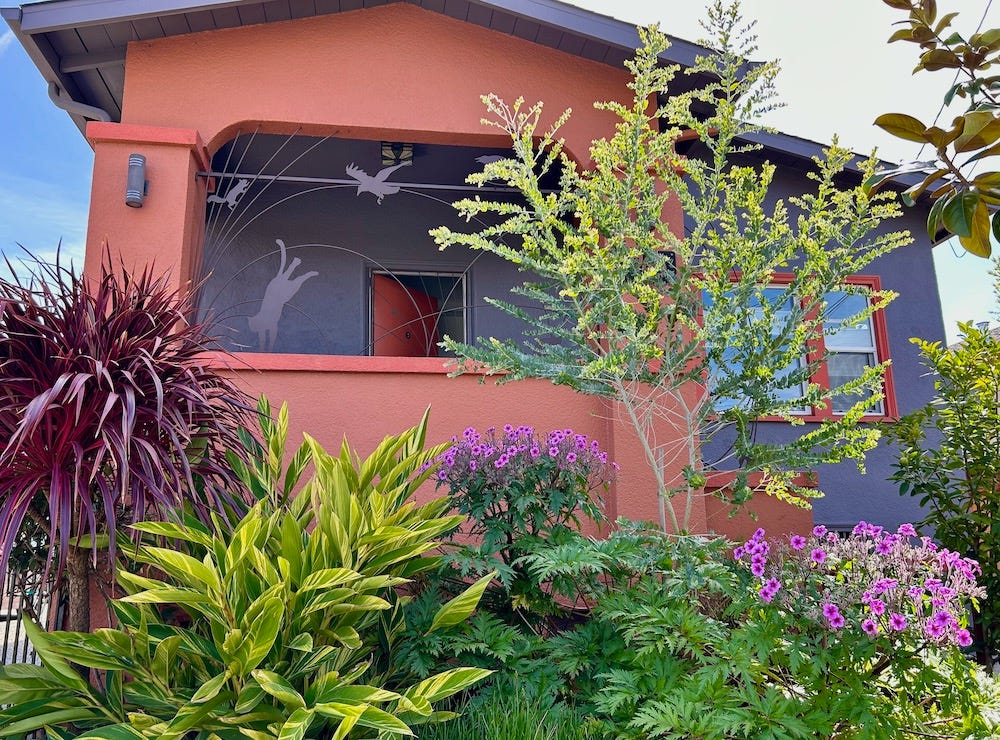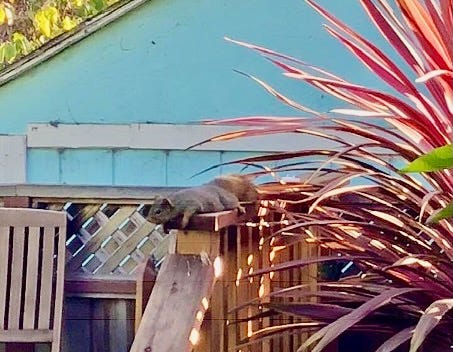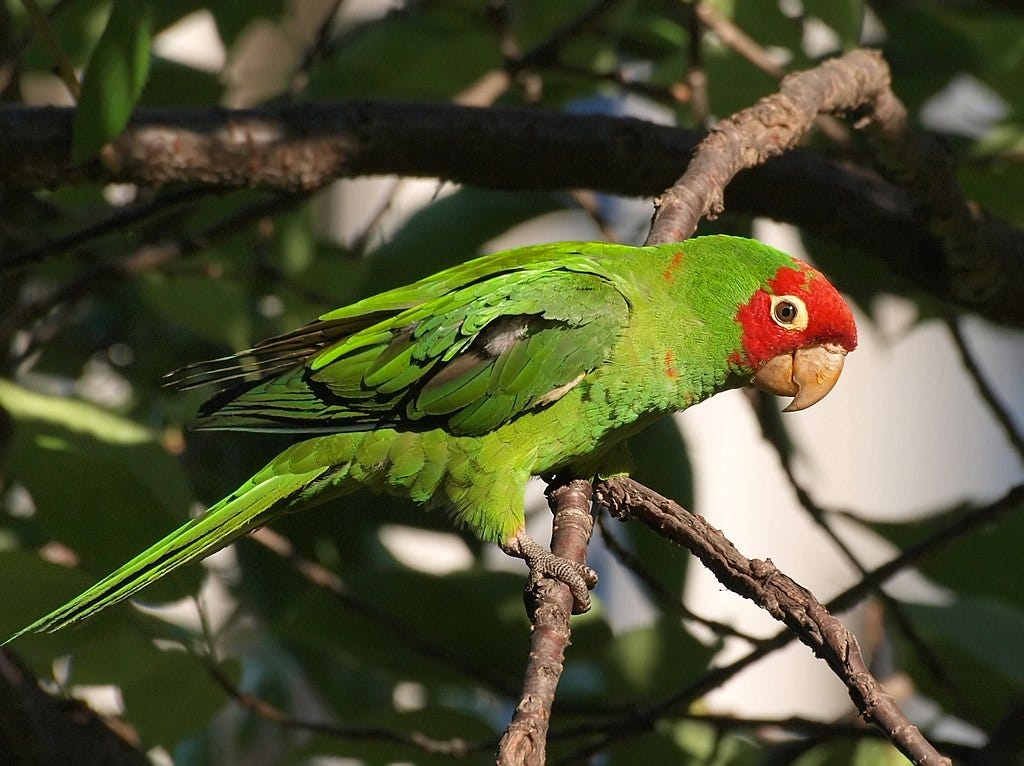If you just signed up for this newsletter: Thank you! I don’t always write about women or aging; as a bit of a “scanner,” my interests vary. Two related topics I keep coming back to are nature and awe, which I’ll cover a bit this month. Click here for some recent and popular posts.

A few months after we moved into our house in Oakland, Rafael told me he’d heard turkeys. I scoffed. “You don’t even know the difference between squirrels and chipmunks,” I told him (he doesn’t). “What makes you think you know what a turkey sounds like?”
Next thing I knew, people in our neighborhood Facebook group started posting photos of wild turkeys. Rafael hadn’t been hearing things. I had to admit I was wrong.
Then, I nearly ran into this guy while walking down the sidewalk around the corner from our house:
A recent Facebook memory reminded me of this encounter — and of the joys of seeing wildlife in cities. Most of us live at such a distance from nature that the smallest sightings are a cause for celebration.
We’ll take possums, raccoons, squirrels — whatever we can get, just to experience a bit of wildlife in our lives.
Our Oakland neighborhood is residential, but it’s a 10-minute drive from downtown and at the center of the very urban San Francisco Bay Area. Yet we have an abundance of turkeys, rather gigantic raccoons, possums, and various other critters roaming around among the humans. Neighbors have spotted a peacock, though it may be someone’s pet. I love hearing the honks of geese as they fly overhead, a common sound here. Apparently, turkeys fly, too; a neighbor recently caught six of them sitting on her neighbor’s roof.
Even the more common squirrels provide endless entertainment in our backyard, such as when they’re “splooting”:
Why we like seeing nature where we can
We’re in the midst of a serious extinction crisis. Human-made environments are encroaching on the territories of wild animals at an alarming pace. Even in wild places, you’ll see far fewer birds and insects than you would have a few decades ago. I know that my joy in seeing wild things in our urban area is due in part to the fact that they’re becoming more scarce and precious, and in part to the fact that most of us are so removed from nature. These sightings serve as a small reminder that we are all part of nature, and nature is everywhere.
And they’ve surprised me. I hadn’t realized how much wildlife persists even in spite of the obstacles we put in its way. The East Bay, where Oakland is located, has more green spaces than San Francisco, but the City, as it’s known around here, is also home to more wildlife than you might expect.
When I lived in San Francisco, I used to take lunchtime walks by Mission Creek Channel, near my office. The channel provided an unexpected stretch of wildness in the city, frequented by plenty of seagulls and other birds. Sometimes, we’d even see sea lions who’d ventured in from the bay.

Walking just a block from restaurants and shops in Potrero Hill, Rafael and I saw what seemed to be a strange-looking cat across the street — before we realized it was a fox. I hadn’t known they lived in the City.
San Francisco tends to be quiet around Christmas, maybe because so many people visit family elsewhere. A friend spent a recent Christmas in the Mission, and on her way back to Noe Valley she saw a coyote walking down the street. This is an area with apartment buildings and some houses, but not a lot of what you’d think of as nature. Yet nature had found its way in.
The parrots of San Francisco are famous, and although they were brought over as pets, they’re certainly wild now.
They’re not only on Telegraph Hill (though I highly recommend the movie about that flock); when I lived a block away from Dolores Street in the Mission, where a flock lived in the palm trees, I’d regularly hear them flying overhead. They’re such loud squawkers that a house for sale that Rafael and I checked out in Potrero Hill had parrot noise in its disclosures — as if anyone would mind that!
Sometimes, seeing all these wild things in the city gives me a small bit of hope that if we screw things up for humanity, the wilderness will take over — more quickly than we might think.
I don’t want to minimize how much we’re screwing things up for all of nature. But encounters with nature in the city can help remind us that we need to do more to protect the wildlife that’s left.
Bringing wildlife back
During the height of the pandemic, when people stayed home more and cars weren’t dominating our cities, urban wildlife sightings increased. But the wild things have always been there; we’ve been invading their territories for centuries. It’s up to us to do what we can to enable them to live and to thrive — which all creatures deserve. Plus, like I’ve said before, wildlife is not a nice-to-have but is necessary for the survival of humans.
Now and then, a few positive stories pop up. Peregrine falcons, reduced to 324 nesting pairs in 1975 because of widespread DDT use, have made a comeback. It turns out they’re well suited to living in urban environments. In a wilder area, the reintroduction of wolves to Yellowstone Park had unexpected, wide-ranging benefits. Legal protections for blue whales have saved them from extinction, though they’re still endangered.
We need to do much more, of course. What will it take?
A good first step is for as many people as possible to feel our connection with and reliance on the rest of nature. Nature is one of the top things that inspires awe in humans (and maybe other creatures?), something I’ll be writing about more soon. That feeling of awe and connection can unlock more than we may realize, and nature is one of the keys.
What wildlife have you encountered in the city? Let me know in the comments!






Nice column! I like to think about how is isn't us and nature--we are nature too. Maybe if we thought of ourselves as part of it instead of its dominator, that would help.
Nice article! I do a lot of hiking in the mountains of SoCal and I always spot a diverse wildlife, specially rabbits. I also take lots of walks around my neighborhood which is a large city near downtown LA, and I keep seeing more coyotes roaming around in the neighborhood; and at night they can easily pass as dogs. I think they're becoming more used to us in the urban setting.